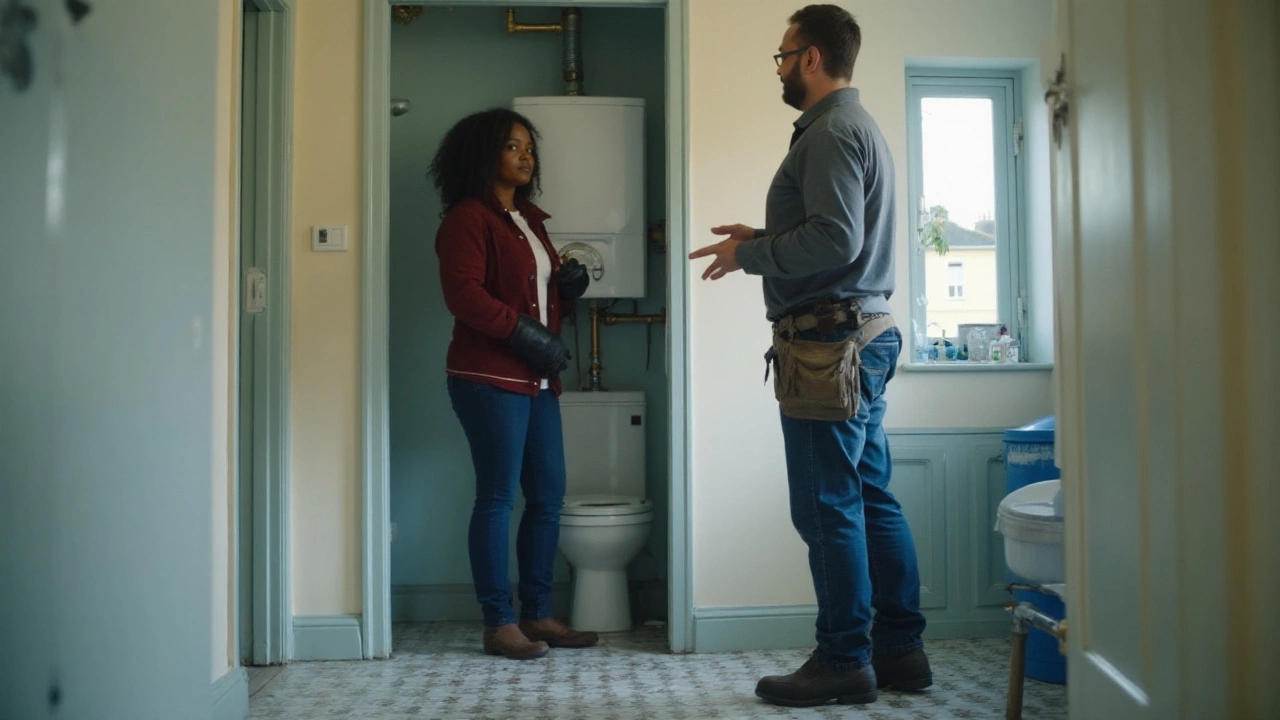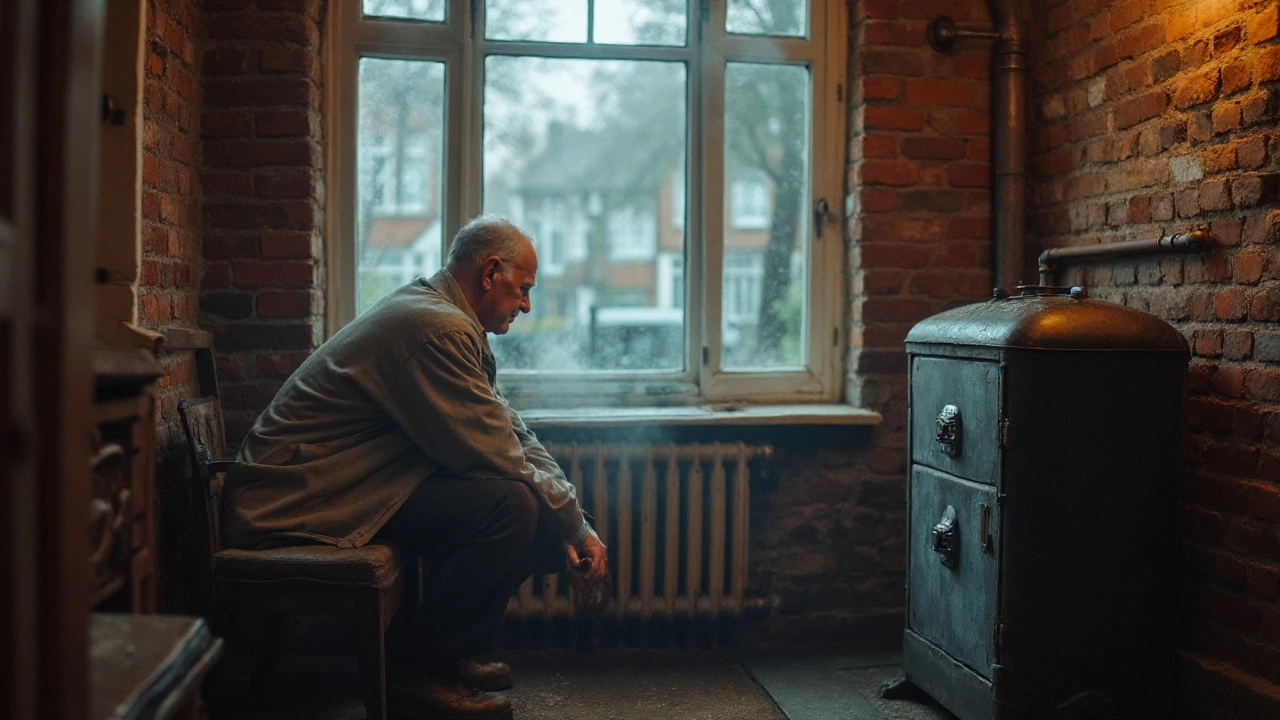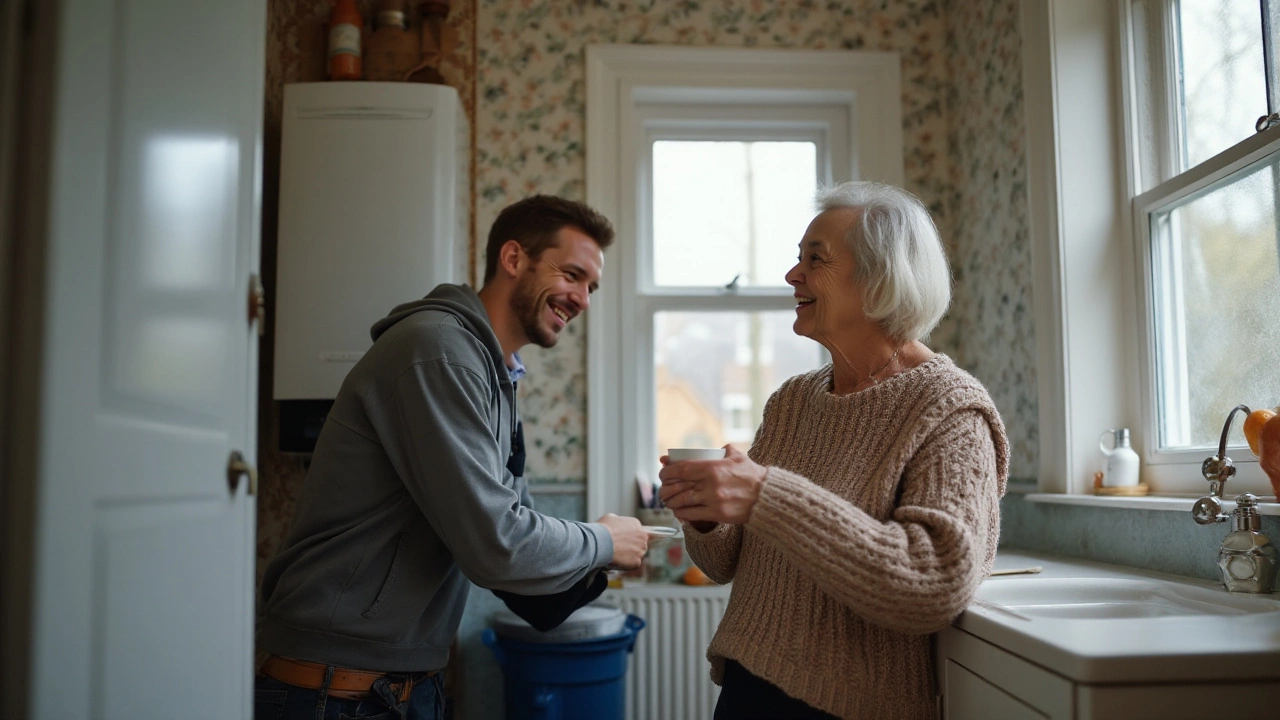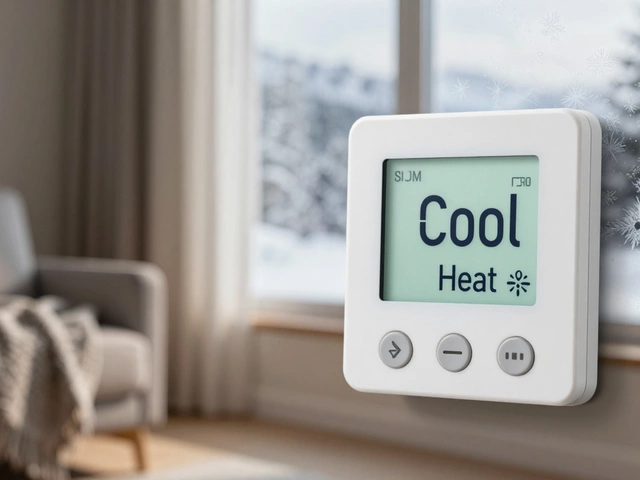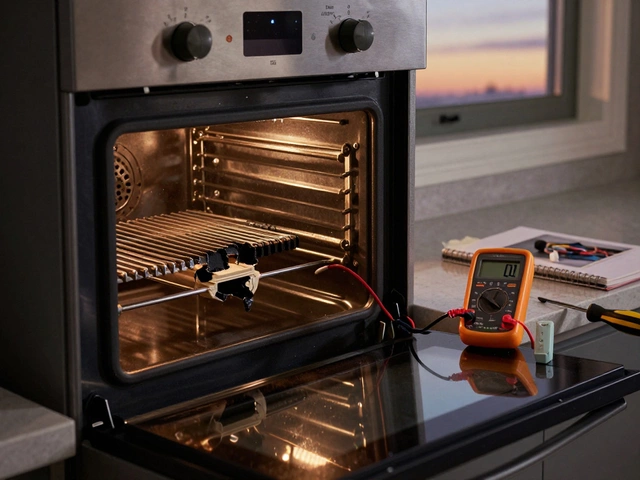You’re getting a new boiler and your first thought is not about fancy controls. It’s, “Can we still use the toilet?” Fair. The short answer: in most homes, yes-you can still flush during the work, as long as the cold water supply stays on. If the installer shuts off the water for part of the day (often happens), you can still flush with a bucket of water. Heating will be off, hot water will be off for a chunk of the job, but the loo usually survives the chaos.
I’ve been through this in older villas in Auckland and chilly UK semis. Same pattern every time: the toilet keeps working unless the main water is isolated. When the main is off, it’s bucket-flush time. Let’s make your day easier with clear rules, simple steps, and a few tricks so no one is caught out mid-install.
TL;DR: Can You Use the Toilet While the Boiler Is Being Replaced?
Here’s the quick take, so you can plan without stress.
- Yes, you can use the toilet if the cold water is on. Toilets fill with cold water, not hot.
- If the installer turns off the water, your cistern won’t refill-but you can flush by pouring 6-9 litres (one big bucket) straight into the bowl.
- Expect heating to be off the whole time. Hot taps will be off for hours or until commissioning is complete.
- Electric showers work if they’re true electric units. Mixer showers that rely on the boiler won’t.
- Typical water-off windows: 2-4 hours during changeover. Whole day if pipework is being rerouted or walls opened up.
That covers most homes, whether you’ve got a combi, a system boiler with an unvented cylinder, or a conventional boiler with tanks in the roof. If you’re in New Zealand where the term “boiler” is rarer and you’re replacing a gas unit feeding a cylinder, the same idea holds: toilet = cold water; it’s usually fine.
Why you can trust this: Toilet cisterns are supplied by cold mains or a storage tank, not the boiler. Manufacturer manuals (Kohler, Caroma, Toto) specify cold-feed cisterns, and gas bodies (Gas Safe Register in the UK; the Plumbers, Gasfitters and Drainlayers Board in NZ) note that gas isolation and heating drain-down don’t require cutting off cold water for the whole day unless the main is being altered.
What Works and What Doesn’t While the Boiler Is Swapped
Different fixtures behave differently during a boiler replacement. Use this as your quick map.
| Fixture / Appliance | Usable During Replacement? | Conditions | Notes |
|---|---|---|---|
| Toilet (standard cistern) | Yes, usually | Cold water must be on | If water is off, use bucket-flush (6-9L poured fast into bowl) |
| Toilet (pressure-assisted) | Sometimes | Needs mains pressure to refill | No refill if water off; bucket-flush still works |
| Bidet seat / washlet | Partially | Needs power; cold water on | Heated water/dryer may not work if hot feed is mixed or power isolated |
| Cold taps | Yes, usually | Unless main is isolated | Brief shutoffs are common during pipe tie-ins |
| Hot taps | No | Hot off until commissioning | Plan for no hot water for most of the day (or longer) |
| Shower (electric) | Yes | Dedicated electric heater; cold feed present | Temperature may vary if cold pressure changes |
| Shower (mixer via combi) | No | Boiler provides hot | Will be cold or shut down via thermostatic valve |
| Shower (mixer via cylinder) | No | Hot store off/drained | Wait until cylinder is reinstated and reheated |
| Bath | No (hot unavailable) | Unless you accept a cold bath | Not fun; skip it |
| Radiators / underfloor heating | No | Heating loop drained/isolated | Air may be bled later; expect noises on first heat-up |
| Washing machine | Maybe | Cold-fill models only; water on | Avoid running it while installers need water off |
| Dishwasher | Maybe | Usually cold-fill; water on | Skip on install day to avoid clashes |
| Gas hob / oven | No | Gas isolated | Use microwave or electric plug-in hob instead |
| Towel rail (electric) | Yes | Power on | Handy for drying when hot water is off |
| Instant boiling tap | No | Usually isolated; hot tank off | Boil a kettle instead |
Timeframes to expect (from real-world installs):
- Water off: 2-4 hours typical for like-for-like swaps; up to a full day if rerouting pipes or moving the boiler/cylinder.
- Hot water back: Same day by late afternoon on straightforward jobs; next day if flushing, power-flushing, or wiring delays.
- Heating back: Often late same day; next day during shoulder season commissioning or if radiators need extra bleeding.
Why installers isolate things: safety and clean joins. In the UK, Gas Safe rules require gas isolation during work. Unvented cylinders (UK G3; NZ G12 equivalent in spirit) may need drain-down and careful recommissioning. Those steps don’t touch your cold feed unless they have to tie into the mains or change valves.
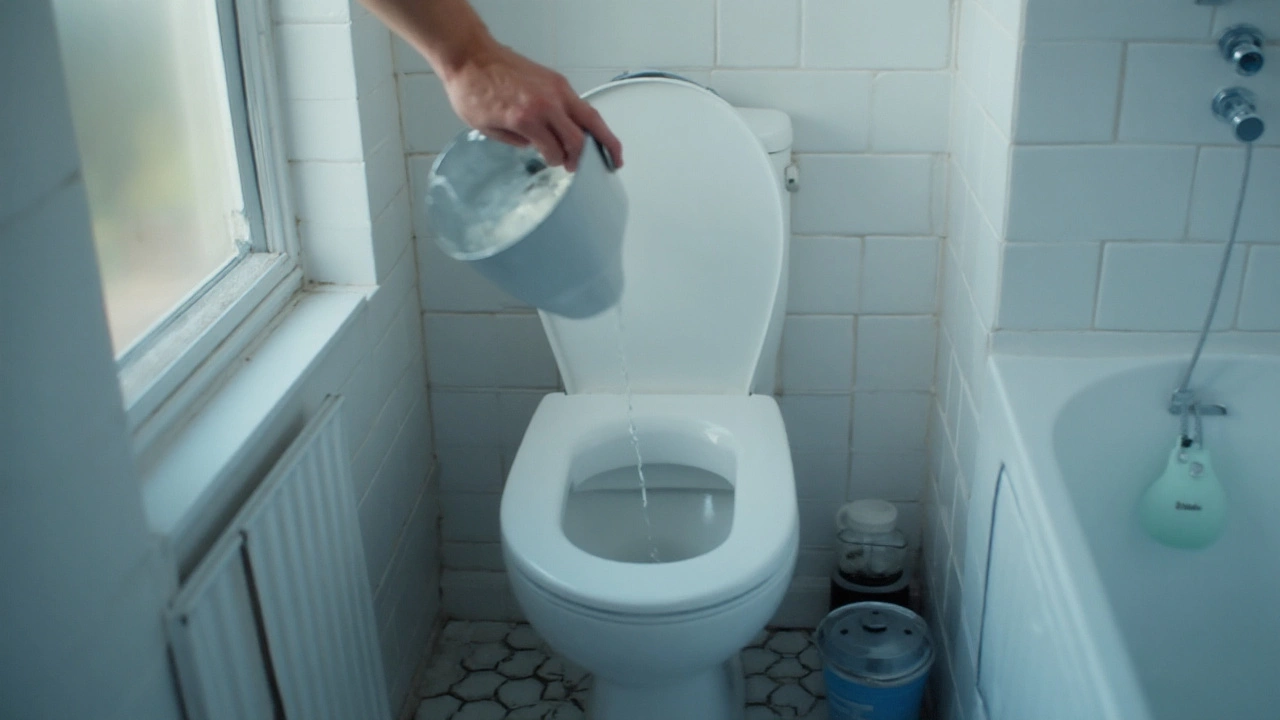
How to Get Through the Day: Steps, Buckets, and No-Drama Planning
Here’s a simple game plan that keeps your bathroom routine intact and avoids awkward moments while the crew is mid-solder.
Before the installers arrive (the night before or early morning)
- Ask for the plan. Quick questions: “Will the cold water be off, and for roughly how long? When do you expect hot water back?” Pros know the windows.
- Fill two buckets. A standard toilet flush is about 6-9 litres. Fill two big buckets (or a sturdier storage tub) and leave them by the bathroom.
- Move laundry and dishwasher runs. Get them done the night before. Don’t queue appliances that need water during the swap.
- Shower early if you need hot. Hot water may be gone most of the day. If you have a true electric shower, note the isolation switch location just in case.
- Clear access. Boilers hide in tight cupboards. Clearing space speeds the job-and gets your hot water back sooner.
During the install
- Toilet use with water on: flush as normal. No special steps needed.
- Toilet use with water off: bucket-flush. Pour one bucket quickly into the bowl (not the cistern). Aim for a fast, single pour to trigger a siphon. If the bowl doesn’t clear, pour half a second bucket.
- Handwashing: keep a bottle of water and a pump soap by the sink. If water is off, use a wet wipe and sanitiser, then rinse with a splash from the bottle.
- Keep taps off when asked. Installers may ask for “no water use for 30 minutes” while they solder, press-fit, or pressure-test. Stick to it-turning a tap on can drop pressure mid-test.
- Don’t use gas appliances. Gas will be isolated; leave the hob and gas oven alone until the sign-off.
After commissioning
- Run hot taps to purge air. Let each hot tap run until steady. Expect splutter at first.
- Check toilet for weeps. Peek at the flexi hose and isolation valve under the cistern. If anything drips, tell the installer before they leave.
- Bleed radiators if asked. The team may do a first pass. If a room gurgles later, a quick bleed sorts it.
- Set timers. Heating and hot water programs may be reset. Copy your old schedule or ask the installer to mirror it.
Bucket-flush 101
- How much water? One big bucket (6-9L). If you only have small containers, two or three fast pours can mimic a flush.
- How to pour: lift the seat, aim mid-bowl, pour quickly from some height (about waist level). You’re imitating the surge from the cistern.
- What not to do: don’t pour slowly-that just raises the water level. Don’t pour into the cistern if the water is off; it will simply sit there unless you add enough to cover the outlet and lift the flush valve.
- Odour control: if you’re saving water, a “yellow let it mellow” plan is fine for a few hours. A quick bucket flush later clears it.
Pro tips from the field
- Two bathrooms? Nominate one as the “install side” and one as “family side.” Tell the crew which one they can isolate without panicking the household.
- Old stopcocks can leak if forced. If your main is stiff, ask the installer to operate it, not you.
- Pressure-assisted toilets can be noisy when water returns-normal. The tank repressurises; the sound fades.
- Thermostatic shower valves may refuse to run on cold-only and shut down to prevent scalds. Don’t fight them; it’s a safety feature.
- Have a kettle ready. It covers tea, washing up, and makes a nicer shave when hot water is off.
How long will you be without what?
- Like-for-like combi swap, same location: 1 day. Cold water off in 2-4 hour chunks. Hot back late day.
- System boiler + unvented cylinder replacement: 1-2 days. Cold off in intervals; hot may be next day while the cylinder heats and safety checks finish.
- Conventional boiler to combi conversion (removing tanks): 2-3 days. Expect longer cold-water isolation while pipework changes happen.
These windows line up with what major boiler brands brief their installers for 2025. When parts of the job go faster (press-fits instead of soldering, prefabricated jig frames), you’ll get your water back sooner.
FAQs, Edge Cases, and What to Do If Things Get Weird
Quick answers to the follow-ups people ask on install day.
Will the toilet definitely work?
In most homes, yes. The toilet runs on cold water and isn’t tied to the boiler. It only stops refilling if the installer turns off the cold main or your loft tank supply. When that happens, use the bucket-flush method.
What if I have a low-pressure (tank-fed) cold supply?
Some older UK homes feed the toilet from a loft tank. If the system is drained or that line is isolated, the cistern won’t refill during the work. Bucket-flush still saves the day.
Can I use the toilet while they’re pressure-testing?
When the installer says, “Please don’t use water for 30 minutes,” take it seriously. A flush or tap opening can skew a pressure or tightness test. Ask them for safe windows to use the bathroom.
What about apartments with shared risers?
In some flats, installers have to shut a building riser to isolate a unit. That means a hard no on refills during that window. Plan bucket-flushes and quick bottled-water handwashing until the riser is back on.
We’ve got an electric shower-can we still shower?
If it’s a true electric shower (heats water itself), yes, as long as cold water is on and power isn’t isolated. If the installer turns off power at the consumer unit for wiring, you’ll have a gap. Thermostatic mixer showers that rely on the boiler won’t work.
Is it safe to use a bidet seat during the swap?
Yes if power and a cold feed are available. The warm-water function may be cold or disabled. If the unit mixes from your hot line, the temperature may be off until hot water is back.
How do I avoid smells if we’re limiting flushes?
Use a two-part plan: close the lid, keep the bathroom extractor on, and do a timed bucket-flush every few hours. A cup of baking soda in the bowl helps if you’re stretching time between flushes.
Could using the toilet damage the install?
No, unless the installer has asked for a no-water window. The toilet is on the cold side; the boiler swap is on the heating/hot side. Respect their timing and you’re sweet.
What if water doesn’t come back after the job?
Start with basics: check that the main stopcock and any local isolation valves are open. Try two taps-one cold at the kitchen and one upstairs. If still nothing, call the installer; a valve may have been left closed or a filter may need purging.
My toilet is gurgling now-normal?
After plumbing work, trapped air can cause gurgles. One or two flushes usually clear it. If gurgling persists with slow draining, you might have a partial blockage unrelated to the boiler work; a plunger or drain snake sorts most cases.
Any official guidance to lean on?
Yes. Gas Safe Register (UK) requires gas isolation and tightness testing; there’s no rule to cut cold water all day unless necessary. Unvented hot water systems follow manufacturer and Building Regulations rules for drain-down and re-commissioning. In New Zealand, the Plumbers, Gasfitters and Drainlayers Board stresses certified work and safe isolation; again, toilets are on the cold side and usually unaffected.
Tenants: what can you ask for?
Reasonable notice, a clear time window for water/gas off, and temporary access to a working toilet (bucket-flush counts in short windows). Most landlords coordinate the work to avoid all-day water cuts.
Do I need to turn anything off myself?
No. The installer will isolate what they need. If they ask you to show the stopcock or consumer unit, just help them find it. Don’t preemptively shut anything unless asked.
Edge case: rainwater/greywater toilets
A handful of homes use rainwater-fed cisterns. If that system is independent and still live, your toilet will keep working even if the mains is off. If it’s mains-backed and the main is off, bucket-flush remains the fallback.
What if we’re on a rural supply or a pump?
If your cold water relies on a pressure pump and the power is off during wiring, your toilet won’t refill. Still fine to bucket-flush. Once power returns, the pump may need a reset.
Bottom line
During a boiler swap, the toilet is the least of your worries. Keep a bucket or two handy, ask for the water-off windows, and you’re sorted. The rest-hot water, heating-comes back after safe testing and sign-off.
Notes from experience: Replacement timelines in 2025 have improved thanks to press-fit systems, magnetic filters, and pre-jigged frames. That shortens water-off periods. Still, no two houses are the same-Victorian copper, Kiwi villas with creative plumbing, new-builds with unvented cylinders-they all behave a bit differently. Good installers communicate; you’ll rarely be without a working loo for more than a couple of hours, and even then, a bucket makes it a non-event.
